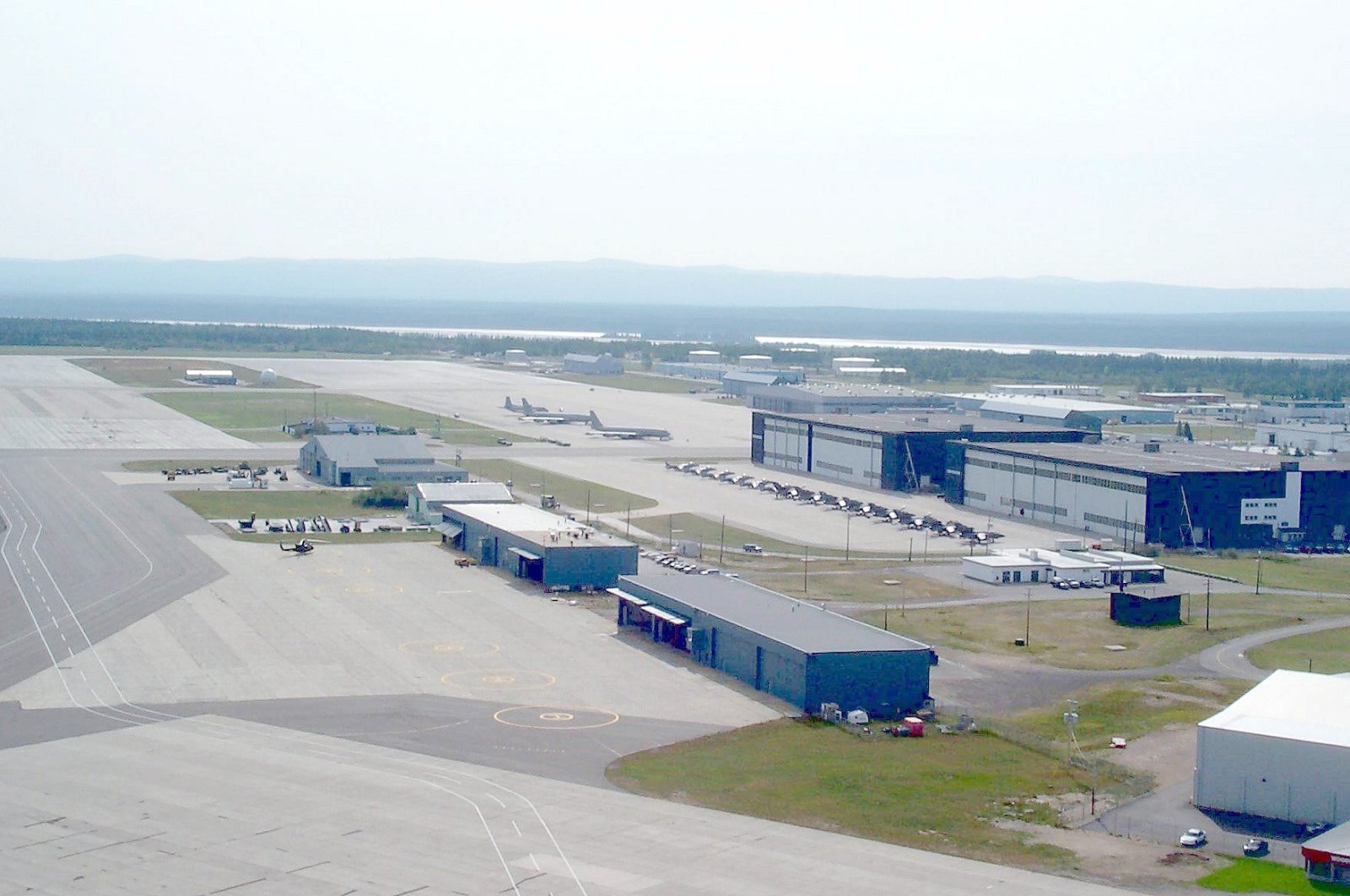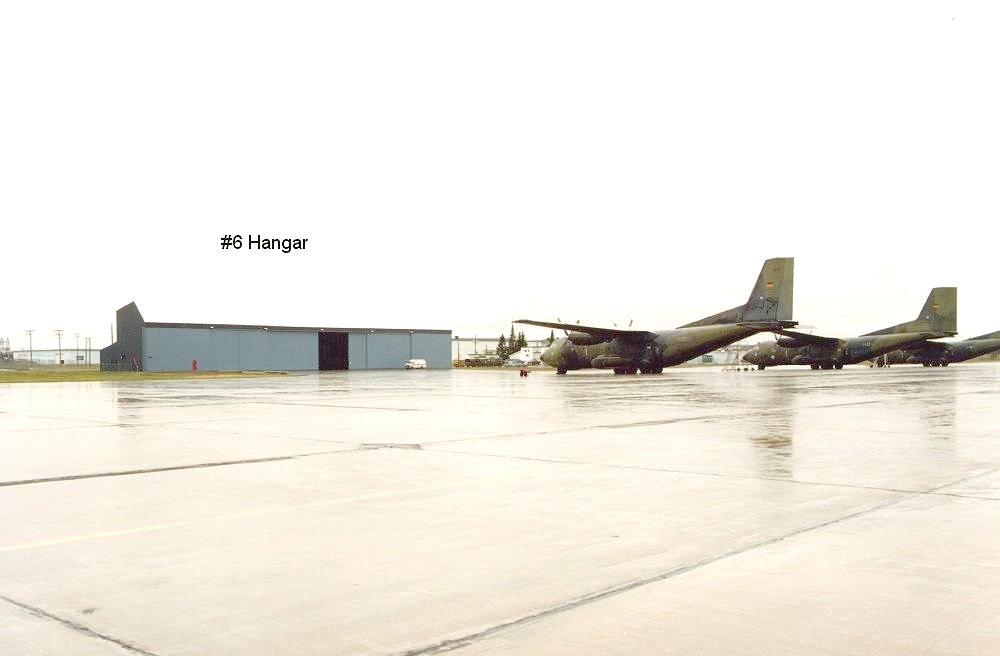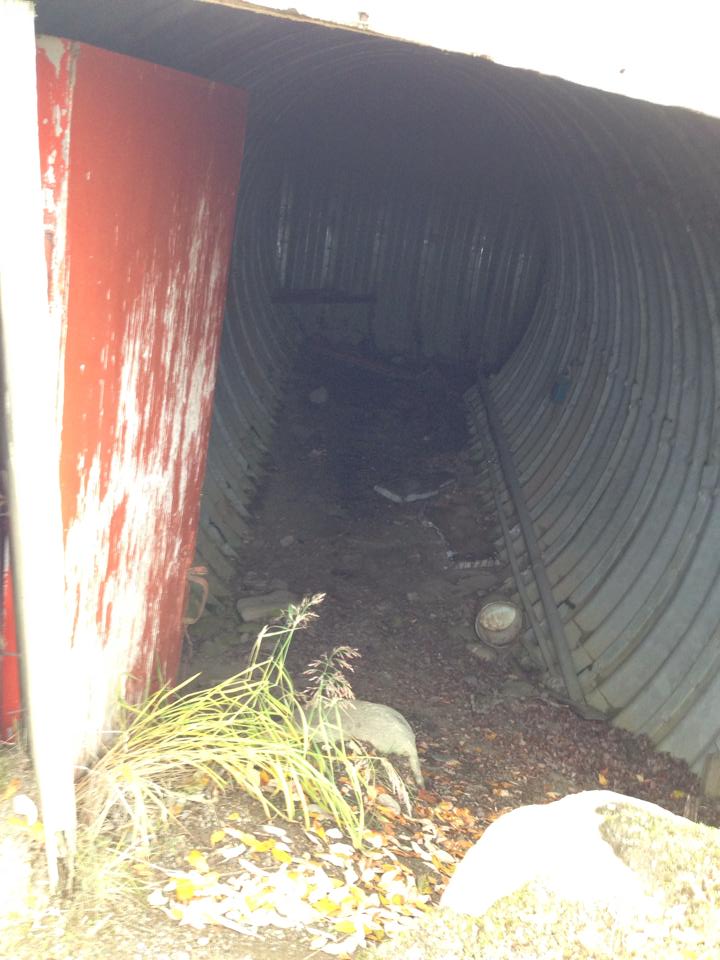I'm always surprised to find new types of installations or
buildings that I didn't know existed. I know that I know a very small
corner of a much bigger pie of Cold War knowledge, but I had no idea I'd
missed an entire class of hardened structures from the 1950s!
Moleholes
The "Molehole" (aka Mole-hole, or Mole Hole) is a hardened Alert building that would house, feed, and entertain American air crews flying B-47 Straojets, Air-refueling tankers like the KC-97, or other long range aviation assets' air crews, while they were waiting for the order to strike the Soviet Union. They came in three sizes globally, depending on where and what kind of deployment of aircraft they would support; 18,000 square feet (70 men); 22,500 square feet (100 men); and, 31,000 square feet (150 men) - different versions of the molehole were built at SAC bases worldwide. The six moleholes in Canada were all of the 18000sq ft / 70 man variety and were completely built by late 1959 or 1960.
"...alert areas went in at 65 SAC installations nationwide during 1956 to 1960, with a partially below ground, reinforced concrete alert quarters for the pilots built at each apron. The alert quarters, called moleholes, were in effect partially hardened, and not surprisingly were designed by the same Omaha architectural-engineering firm responsible for SAC’s underground command center of this same period, Leo A. Daly. With dispersal, SAC made some of its alert aprons bomber-only and some tanker. By the early 1960s bombers and tankers were sometimes on alert at a single installation—with tanker pens in addition to the Christmas tree configuration, and with house trailers again brought to the tarmac."
- "Cold War Infrastructure for Strategic Air Command: The Bomber Mission"
Prepared for; Headquarters, Air Combat Command, Langley AFB, Virginia
Moleholes
The "Molehole" (aka Mole-hole, or Mole Hole) is a hardened Alert building that would house, feed, and entertain American air crews flying B-47 Straojets, Air-refueling tankers like the KC-97, or other long range aviation assets' air crews, while they were waiting for the order to strike the Soviet Union. They came in three sizes globally, depending on where and what kind of deployment of aircraft they would support; 18,000 square feet (70 men); 22,500 square feet (100 men); and, 31,000 square feet (150 men) - different versions of the molehole were built at SAC bases worldwide. The six moleholes in Canada were all of the 18000sq ft / 70 man variety and were completely built by late 1959 or 1960.
"...alert areas went in at 65 SAC installations nationwide during 1956 to 1960, with a partially below ground, reinforced concrete alert quarters for the pilots built at each apron. The alert quarters, called moleholes, were in effect partially hardened, and not surprisingly were designed by the same Omaha architectural-engineering firm responsible for SAC’s underground command center of this same period, Leo A. Daly. With dispersal, SAC made some of its alert aprons bomber-only and some tanker. By the early 1960s bombers and tankers were sometimes on alert at a single installation—with tanker pens in addition to the Christmas tree configuration, and with house trailers again brought to the tarmac."
- "Cold War Infrastructure for Strategic Air Command: The Bomber Mission"
Prepared for; Headquarters, Air Combat Command, Langley AFB, Virginia
Hangers
For a
hanger to fit an entire heavy bomber, medium bomber, or air refueling
tanker, it needs to be quite large. A more resource efficient way would be
building a hanger that just barely fit the plane to keep the mechanics
and hardware out of the elements, and could close the door around the
ass end that was sticking outside - that was exactly what the United
States Strategic Air Command did in the 1950s. Those distinct looking
hangers are still at several previously SAC airstrips across the world.The US Strategic Air Command had six such bases where SAC assets were located in Canada.
Namao (Edmonton / Lancaster Park AB)
Cold Lake (AB)
Churchill (MB)
Frobisher (Iqaluit)
Goose Bay (NL)
Ernest Harmon AFB (Stephenville, NL)
Namao, Alberta (3955th Air Base Squadron)
(...now CFB Edmonton -Lancaster Park)
Built
as a refuelling base by the SAC, crews would be stationed for
2-3 month rotations from their home base in the United States.
RCAF Station Namao became Canadian Forces Base Edmonton (Lancaster Park) after unification in 1968.
At least one "nose hanger" is still in existence on the base, conveniently right near the molehole.
At least one "nose hanger" is still in existence on the base, conveniently right near the molehole.
Molehole Location: 53.6595, -113.4467
The
molehole looks to still be in use, but I do not know by which part of
the Canadian Forces. It is listed by the Department of Treasury as
being federal building # 124206, in fair condition, with 2,147 sq. m. (23110.12 sq ft) of floor space - which doesn't jive with previous information!
View Larger Map
View Larger Map
Seriously? There's a trailer park beside this one? GO ARMY!
Cold Lake, Alberta (3950th Air Base Squadron)
Molehole Location: 54.3948, -110.2638Built as a refuelling base by the SAC, crews would be stationed for 2-3 month rotations from their home base in the United States.
Still in use by the Canadian Forces today, I believe called Building 104, was expanded with an addition. The Molehole at CFB Cold Lake gets usedfrequently as the Air Force Tactical Training Centre (AFTTC)
 |
| Building 104 @ CFB Cold Lake https://www.flickr.com/photos/59434634@N05/7973074760 |
View Larger Map
Churchill, Manitoba (3949th Air Base Squadron)
Molehole: End of Runway 33 - Destroyed |
| Courtesy Ivan Abolit |
Original SAC hangers are still in existence on the former base.
Frobisher Air Base, Nunavut
Molehole: Unknown - Presumed DestroyedSAC refuelling and/or Reconnaissance Base
Home of the USAF Strategic Air Command refuelling operation at Frobisher, an SAC base closed in 1963, when its refuelling operations were mostly taken up by tankers flying out of Goose Bay.
Original Nose Hanger:
Goose Bay, Labrador
(aka Building 248 per DND 5 Wing Goose Bay Area Site Plan, 1998)
 |
| "Goose Bay Alert Facility or Mole Hole taken in early 1962 by Hank Brown." |
 |
| CFB Goose Bay - 2001 |
 |
| CFB Goose Bay - 2001 |
 |
| CFB Goose Bay - 2001 |
Molehole: 53.3086, -60.4017
Reportedly, the molehole was still in use in 2002; I don't have any more recent information than that.
According the the Treasury Board Secretariat the building is "occupied" (as opposed to vacant. It is building number 125892 in their registry, which shows it was built in 1959 (which matches my other information), and measures 2716 sq. m. (29234.8 sq ft) which does *not* jive with the information I had.
At least two nose-hangers are in existence, and I have marked the map below with the other two (which are shown in the picture above!).
View Larger Map
 |
| "Remains of former USAF storage bunker - 1 October 1983." Credit: Barry Yager |
 |
| "Remains of former USAF secure area - 1 October 1983" Credit: Barry Yager |
Ernest Harmon AFB, Newfoundland (4081st Strategic Wing)
Molehill: 48.5534, -58.5399
From what I read online, this molehole is now an accountant's office, and self-storage facility.
View Larger Map
 |
| Photo Credit: Shannon K. Green via: http://planecrashgirl.blogspot.ca/2013/08/the-worst-disaster-in-history-of.html |
At least four nose-hangers are clearly visible on the property of the former base. I believe the below is an example of a Luria Engineering multi-purpose wing hangar.
 |
Photo Credit: Peter Mansell |
The Big Picture
Sources:
The City of Ottawa
http://www.geocities.ws/kc97stratofreighter/301ars.html
http://albertacanada.com/Cold_Lake_Hot_Shots_%28June_2010%29.pdf
http://www.mcneillifestories.com/fire-walkers-chapter-1-a-nuclear-challenge/
http://www.globalsecurity.org/wmd/facility/bomber_alert.htm
US Nuclear Weapons in Canada, John Clearwater
John Clearwater
http://cryptocomb.org/Cold%20War%20Infrastructure%20for%20Strategic%20Air%20Command-The%20Bomber%20Mission.pdf

































.png)